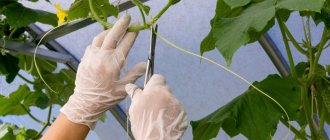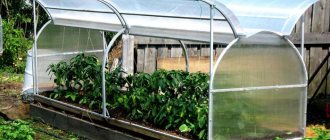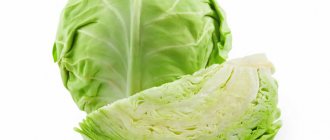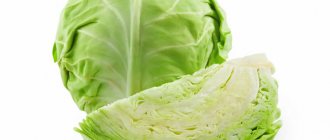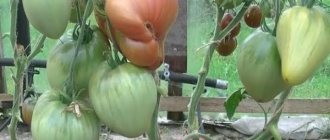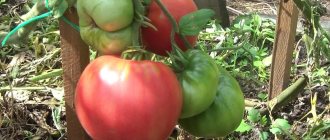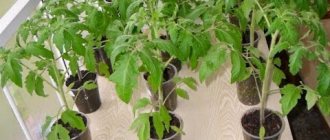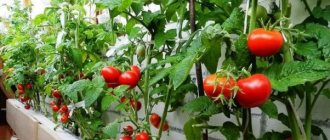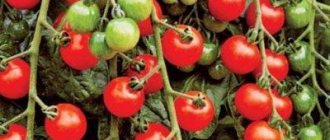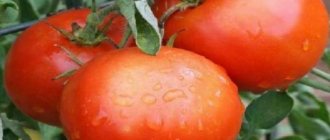- Vegetables
07.01.2021 11557
VK
The Mongolian dwarf tomato is a unique and unusual variety. This is a variety of amateur selection; little is known about its origin and the exact date of appearance of the variety is not known. But for several years now the controversy surrounding it has not subsided. The uniqueness of the Mongolian dwarf lies in its characteristics: it is super early, unpretentious, and at the same time, productive and tasty. A peculiarity of the variety is that the trunk of the bush at a height of 20 cm begins to bend sharply downwards. The stepsons also tend to the ground, resulting in a low creeping bush.
| Buy 10 seeds – 40 rub. | Information about practical experience in growing the Mongolian dwarf tomato variety in the conditions of the Nizhny Novgorod region was provided by the owners of the nursery and store “Fazenda” from Dzerzhinsk . Features and recommendations are made based on my experience. For orders and consultations through the group in Odnoklassniki, please contact us! |
Unfortunately, despite having such positive qualities, the Mongolian dwarf tomato is not yet very common among summer residents. This is probably due to the lack of seeds in garden stores; they can only be ordered from private collectors.
Therefore, when the opportunity arose, we purchased the seeds of this legendary variety for our team. Our first growing experience did not please us. At the end of the season, most of the plants became infected with late blight, and the taste of the ripened tomatoes was not impressive. But when harvesting the bushes, it became obvious that the variety’s potential yield is high; a large number of ovaries have formed on the plants. This is a feature of the variety - the fruits are located under the leaves and are not very noticeable. Therefore, it was decided to give the variety another chance. The second season of growing Mongolian dwarf tomatoes turned out to be successful, we all really liked the variety. After two years of cultivation, it is already possible to draw conclusions about the characteristics of the variety, so we decided to give our feedback on the characteristics and yield of the Mongolian Dwarf tomato.
Origin of the Mongolian dwarf
It is believed that this tomato variety was bred by Russian breeders from Novosibirsk. At the moment, it is not yet listed in the state register of breeding plants. This is due to the fact that its seeds are not so easy to acquire. However, such seeds are sold on many specialized Internet resources and vegetable markets.
Mongolian dwarf is an undemanding plant. It can grow in northern regions from late spring to early autumn, as well as in dry areas.
Tomatoes "Mongolian Dwarf" are the shortest growing
Mongolian Dwarf tomato seeds are difficult to acquire
Mongolian dwarf tomatoes can reach a weight of 200 g
What makes the variety unique?
Until recently, Mongolian dwarf seeds were difficult to find and buy; they were purchased secondhand from friends. Now, thanks to popular recognition, this has ceased to be a problem. Mongolian dwarf seeds are produced by the following: “Ural summer resident”, “Partner”, etc.
Over the past few years, many well-known companies have begun to produce Mongolian dwarf seeds.
Such love for a variety that is still considered amateur is not without reason. Let's figure out why he is so interesting.
Description and characteristics of low-growing tomato
Before choosing this variety for planting on your summer cottage, you need to understand its characteristics and features. We'll talk about this further.
Appearance
This is currently the shortest growing tomato. The height of the bush does not exceed 30 cm, which does not negatively affect the size of the fruit.
The bush spreads along the ground, forming new stepsons. As a result, the width of the bush can reach 1 meter or more. The leaves are narrow with a strong edge. There are many small leaves on the bush.
The stems are thin and fragile. The root system is shallow, but it is enough to hold the bush during strong winds. The fruits are collected in clusters.
Basic qualities of fruits
Despite the fact that the bushes are not tall, the fruits of the Mongolian dwarf weigh up to 200 grams, which is a good indicator. The variety is early ripening, so the fruits are not affected by late blight if properly cared for.
The bright red fruits are dense and juicy inside. The taste is not much different from regular tomatoes. We can say that the taste is standard “tomato”. You can collect up to 10 kg of quality tomatoes from a bush.
Advantages and disadvantages
As practice shows, the Mongolian dwarf grows well in the eastern and southeastern regions of Russia, where the summer is short. However, before deciding to plant in a particular area, it is best to familiarize yourself with the pros and cons of a given variety. Let's start with the pros:
- high yield of the bush;
- there is no need to tie and pin;
- there is no need to create special conditions for cultivation, it can grow in a greenhouse in an open-air garden bed - a universal variety, resistant to temperature changes;
- does not like excess moisture;
- bears fruit until late autumn;
- due to its precocity, the dwarf is slightly susceptible to late blight;
- low bushes withstand strong winds well and do not break.
Every variety has its drawbacks. Although the Mongolian dwarf has few of them, they still exist:
- grows poorly in acidic and heavy soils, as well as in areas with a humid and hot climate;
- the initial growth phase is very long. At first, the plant does not show any growth, and then rapid growth in breadth begins;
- This variety is not yet in state registers, so you won’t be able to buy it at the nearest seed store.
Features, differences from other varieties
It is not difficult to distinguish Mongolian dwarf from other tomatoes. The height of the bush cannot exceed 50 cm. The main trunk, reaching a height of 20 cm, begins to bend sharply downwards, which is a specific feature of the variety. Stepchildren grow from the main trunk and also spread along the ground.
This variety can tolerate long-term lack of watering, but you should not abuse it. Before planting, mulch the soil. In addition, as noted earlier, harvesting can be carried out until late autumn, when the first frost occurs.
The fruits are slightly susceptible to spoilage; even lying on the ground covered with leaves, they retain their properties for a long time, do not crack and do not rot.
Some advice from experts
- To fully ripen tomato fruits in cold summer conditions, it is recommended to cut off all the leaves on the bushes in August, leaving only bare shoots.
- You should not water the Mongol dwarf bushes too often (no more than once every 5-7 days), since excessive watering can lead to acidification of the soil and rotting of the fruits.
- Despite the variety’s resistance to late blight, it is advisable to prevent the disease using biological or chemical means of your choice. This is especially important in unfavorable weather conditions with frequent rain, fog and low temperatures.
- To avoid rotting of the fruits, you should prevent their contact with the soil by mulching the bed. You can additionally place wooden planks or something similar under the fruits.
- As an option, for the “Mongol Dwarf” tomato, you can build a non-standard high bed so that the tomato shoots with fruits, scattering to the sides, hang down without touching the ground.
Features of growing and planting early species
The dwarf was originally intended for cultivation in the eastern regions of Russia, but as practice has shown, due to its unpretentiousness, the Mongolian dwarf is successfully cultivated in other regions. It is not recommended to plant this variety in areas with high humidity. The growing technology is not much different from the growing technology of other varieties.
Seedling and non-seedling growing methods
The Mongolian Dwarf variety is grown by seedlings and seeds. The seedless method is used in the southern regions of the country. 5-6 seeds are placed in a hole. After 2-3 leaves appear, the ground is broken through. After which only strong plants are left.
In places with more severe conditions, sowing with seedlings is used. Seeds are germinated in a pot or greenhouse at home. The seeds are sown so early that in May the bush can be planted in the garden at the beginning of flowering, and by the end of June the first harvest can be obtained.
Use slightly acidic sandy soil. Such soil is sold in gardening stores. The soil is suitable for nightshade or any vegetable crops. You can also fertilize such soil yourself.
To harvest a good harvest, you should follow a number of recommendations:
- in the fall, the beds for planting tomatoes need to be thoroughly plowed;
- per 1 square meter in early spring the following is added: 50 g of superphosphate, 20 g of ammonium sulfate, 25 g of potassium salt;
- pre-treat the seeds;
- plant seedlings and grow them according to the recommendations;
- Properly care for tomato bushes.
Preparing and planting seeds
Before sowing, the seeds must be treated. First you need to pay attention to the expiration date of the seeds. The Mongolian dwarf has a shelf life of 2 years.
Calibrate the seeds and treat them with a disinfectant solution. A mixture of aloe juice and 1% potassium permanganate is suitable as such a solution. Next, pre-soaking and germination are carried out.
Rules for planting and caring for seedlings
The process of sowing seeds for seedlings consists of several stages:
- soil is poured into the container, which is previously disinfected;
- make grooves or holes about 1 cm deep. If the seeds were germinated in advance, then the holes and grooves need to be watered;
- sow seeds in previously created depressions at a distance of 1-2 cm;
- sprinkle with earth and water;
- The container with soil and seeds is covered with polyethylene and placed in a warm place (25-30 degrees) until shoots appear. Usually the first shoots appear after 5-6 days.
You may find our other article useful - “How to grow tomato seedlings: useful recommendations.”
You need to water with warm, pre-settled water as the soil dries out. When 2-3 leaves appear, the plant is transplanted into separate pots. Seedlings that are 45 to 60 days old are planted in the beds. Typically, such seedlings already have 7-8 leaves.
Rules for planting seedlings in open ground
Planting is carried out in a place well lit by the sun, protected from the winds. A week before planting seedlings, the beds prepared in the fall are treated with magnesium sulfate and fertilizers are added. It is recommended to adhere to the following rules:
- plant seedlings in 2 rows, leaving a distance of 50-60 cm between plants and rows;
- seedlings are planted 2-3 cm deeper than they grew in containers;
- Before planting and after, water the soil with water at room temperature;
- 3 days after planting, water the seedlings again;
- Plant more sprouts in place of the dead ones;
- it is necessary to mulch the holes with straw;
- This variety does not require tying, but pegs can be installed.
Planting in a greenhouse
Mongolian dwarf is usually grown in open areas. Those who want to grow it in a greenhouse can do this, but it is important to remember that the yield directly depends on quality ventilation. This is due to the fact that this variety does not like increased moisture and the crop may simply die from its excess.
The greenhouse will need to be opened on warm days, because excess heat also negatively affects the yield of the dwarf. This must be taken into account if other varieties are growing in the greenhouse, which, on the contrary, need a lot of heat and moisture.
It makes no sense to occupy the entire greenhouse with just a Mongolian dwarf. In addition, the beds in the greenhouse must be wide enough, since bushes of this variety spread along the ground. Otherwise, growing Mongolian dwarf in a greenhouse is no different from growing other varieties of tomatoes. You just need to follow the recommendations mentioned above.
Advice from experienced specialists
Caring for Mongolian dwarf seedlings is not at all difficult, but it is recommended to follow certain recommendations:
- 10 days after planting, it is necessary to water with a 2% solution of potassium permanganate to prevent late blight infection;
- the beds should be made a little higher than for other varieties of tomatoes, because Mongolian dwarf creeps along the ground, otherwise higher beds will reduce soil contamination of the stems and leaves;
- The plant should be watered moderately, because the dwarf does not like abundant moisture;
- Experienced vegetable growers recommend placing black film or planks under tomatoes to reduce the likelihood of fruit spoilage by soil pests.
Effective methods of tomato pest control or how to protect your crop
The Mongol Dwarf tomato has a fairly strong “immunity” to various diseases, but it is worth protecting it from pests. And to do this you need to know some ways to deal with them.
The main pests of Mongol dwarf tomatoes are:
1. Slugs. General characteristics
: These are close relatives of snails. In one favorable year, slugs can produce up to 5 new generations. How to recognize them? They move using what is called a leg and leave behind a trail of mucus. After their “lunch,” a noticeable hole may remain in the tomatoes, and as a result, the fruit will be spoiled.
- Fighting methods:
- mechanical methods - lay out small pieces of boards, dark oilcloth or cardboard. Slugs use these things for shelter. They can be easily collected and destroyed the next day after installing such “traps”;
- traditional methods - use a mixture of pepper, kitchen salt and ordinary ash (in equal quantities) and scatter this mixture over the beds with tomatoes;
- Chemicals – “Slug Eater” or “Meta” granules. This method will be effective even during heavy rains (the drug will not be washed off from the soil surface).
2. Aphids General characteristics
: a very common sucking pest due to which the leaves of the plant curl and deteriorate. Found in large quantities on the inside of the leaf.
- Fighting methods:
- the simplest folk method is to use a solution of ordinary laundry soap to spray the bushes affected by aphids;
- chemicals - “Biotlin”, “Aktara”, “Oberon” and others.
3. Spider mite General characteristics
: especially active during the dry season. The presence of spider mites can be detected by the characteristic webs on the plant. The pest itself is very small. But upon careful examination of the leaf plate, especially from the underside, even with the naked eye you can see tiny moving black dots.
- Fighting methods:
- chemical - they use special acaricide preparations, for example, Fitoverm, Oberon, Sunmite and others. Affected bushes must be treated according to the manufacturer's instructions.
Feedings and their quantity
You should limit yourself to feeding at the roots, because it is advisable not to wet the tomato leaves too much. Before fertilizing, the bushes are watered with water. Feeding is done according to the following schedule:
- the first is carried out 2 weeks after planting in the garden;
- the next time the plant is fed before the fruit appears;
- the third is carried out 2 weeks later.
Fertilizers are diluted in 10 liters of water:
- ammonium nitrate 20 g;
- phosphorus-containing fertilizers 80 g;
- potash fertilizers 50 g.
To increase the yield you can use the following additives:
- Dissolve 0.5 manure in a bucket of water.
- 0.5 liters of manure infusion, 2 tablespoons of phosphorus-containing fertilizers, 1 tablespoon of potassium fertilizers are diluted in 10 liters of water. Phosphorus-containing fertilizers are soaked in advance, because it does not dissolve well.
- Add 0.5 liters of manure, 1 tablespoon of potassium sulfate, 7 grams of boric acid to 10 liters of water. 1.5 liters of the prepared solution is applied to each plant.
- Ash solution is also very popular. 200 g of ash per 10 liters. Infuses for 2 days. This feeding will contain many microelements.
- You can use ready-made supplements sold in stores.
- Recently, “green feeding” has become popular. For 200 liters of water take 1 kg of ash, 0.5 kg of manure, 2 liters of whey, 100 g of yeast and fresh grass. The liquid should completely cover the greens. The contents are mixed daily for 2 weeks. When the fertilizer is ready, grass is placed under each plant when mulching, and the liquid is used for watering - 0.5 liters for each bush. Sugar can be used instead of yeast. Take 150 g of sugar per 3 liters of water and leave for 3 days. This mash is added instead of baker's yeast.
Cow or chicken manure is used. It is better to feed before sunrise or after sunset, otherwise the fertilizer may dry out. If tomatoes grow in a greenhouse, then the bushes are fed before sunrise and after feeding the greenhouse should be ventilated.
Harvesting the fruits of the "Mongol dwarf" and its storage
The fruits of this variety can be harvested from early June to mid-September.
Maximum fruiting occurs in August. To speed up the ripening process of all the tomatoes on the bush, it is advisable not to keep the fruits on the plant, but to collect them as they ripen. The fruits are not stored for long, so it is advisable to eat them immediately after harvesting or use them for harvesting.
Reviews
★★★★★
Valentina Vasilievna, 65 years old, pensioner, Moscow region. Last year I planted a Mongolian dwarf in a greenhouse for testing.
He did not get the best place, near the northern wall in the shade. I didn’t take special care of him. I was very surprised when I collected a decent harvest from its bushes. The fruits weighed 120-150 grams. At first they were sour, but after sitting for a while they became sweeter. A very tenacious variety. I recommend. ★★★★★
Angelina Mikhailovna, 58 years old, summer resident, Chelyabinsk. I really liked the dwarf.
Last year I planted it for the first time and decided that next year I will plant it again. It is a small bush and can be planted among other tall varieties. The tomatoes grew tasty and beautiful in color. ★★★★★
Alexey, 37 years old, dentist, Belozerka. This variety is very tenacious.
It always grows well for me because I use my own planting material, collected in the fall. I fertilize with nitrogen and never fertilize. The yields are decent. Hide
Add your review
The Mongolian dwarf is an ideal choice for beginning gardeners because... it is very easy to grow. This variety is unpretentious, the harvest can be harvested from May to October, and the taste of its fruits is not inferior to other varieties. However, experienced gardeners will also enjoy it. This variety is well suited for growing in areas that are unsuitable for other varieties.
0
0
Copy link
Disease resistance
Producers of Mongolian dwarf seeds position the variety as resistant to late blight. This is because it manages to produce a harvest before the period of mass late blight infection. The variety is early, so you can harvest the first tomatoes in June, and the main harvest in July, while late blight usually begins in August.
Moreover, if with the help of preventive treatments it is possible to “slip through” late blight, the Mongolian dwarf will bear fruit right up to the very cold weather.
The situation is somewhat aggravated by the fact that the branches with fruits bend too low to the ground. The risk of tomatoes rotting and all sorts of fungal infections increases. To reduce risks, the soil under the bushes should be mulched - with dry straw, sawdust, cardboard, spunbond, etc.
One more nuance: low-lying Mongolian dwarf tomatoes are easily damaged by caterpillars, slugs, and snails, which you will have to fight - best by mechanical methods (for example, scattering broken eggshells between the beds) or bio-insecticides.
Mongolian dwarf bushes mulched with straw
Let's draw conclusions
Mongolian dwarf and other low-growing varieties have a lot of fans.
- It is these varieties that produce a plentiful and early harvest.
- They are not fussy to care for.
- The bushes of these varieties do not exceed 70-80 cm in height. This makes watering and processing the shrubs much easier.
- Low-growing varieties are characterized by medium-sized fruits.
When choosing these varieties, you will be able to taste the first fruits already at the beginning of summer, when tomatoes of other varieties are just beginning to set fruit.
But after winter we really want to start eating fresh vegetables from our garden, and not imported fruits that have no aroma or taste.
Tomatoes of the Mongolian dwarf variety are excellent in any form; they can be used to enrich dishes, eat fresh, and also be stored for the winter.
